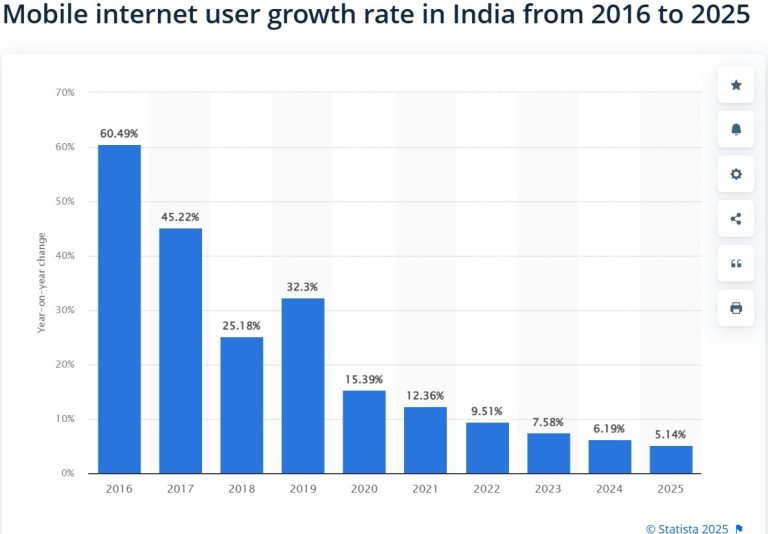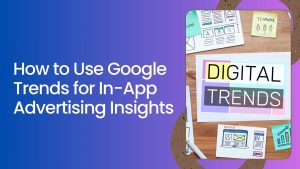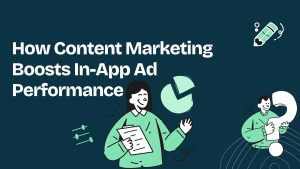Advertising for E-Commerce: The Role of In-App Ads
The Indian Mobile App Ecosystem
- Smartphone Penetration: As of 2022, India boasts approximately 687 million smartphone users, a number that continues to grow, reflecting the country’s increasing digital adoption.
- App Downloads: In 2023, India recorded 26.4 billion app downloads, underscoring the extensive reach and potential of mobile applications as advertising platforms.
Why In-App Ads Matter for E-Commerce

1. Market Growth & Potential
- Current Market Size: In 2025, ad spending in the in-app advertising segment in India is projected to reach approximately US$3,077 million. (Statista)
- Future Growth: The market is expected to grow at a CAGR of 9.40% from 2025 to 2029, reaching US$4,407 million by 2029.
2. Higher Engagement & Better User Experience
Users are more likely to interact with contextually relevant ads when they seamlessly blend with the app’s interface. Interactive elements such as video ads, carousel ads, and playable ads improve engagement rates and enhance brand recall.
3. Precise Audience Targeting
In-app ads utilize behavioral and demographic data to target users with high purchase intent. Advanced AI-driven algorithms analyze factors such as browsing history, location, and app activity to serve hyper-personalized ads, increasing the chances of conversion.
4. Increased Conversion Rates
Since in-app ads appear in environments where users are already engaged, they are more likely to take action. Studies show that click-through rates (CTR) for in-app ads are significantly higher compared to mobile web ads, making them a lucrative investment for e-commerce brands.
5. Variety of Ad Formats
E-commerce brands can choose from a range of in-app ad formats, including:
- Banner Ads – Small, non-intrusive ads placed at the top or bottom of the screen.
- Interstitial Ads – Full-screen ads that appear at natural transition points in the app.
- Native Ads – Ads that blend seamlessly with app content for a non-disruptive experience.
- Rewarded Ads – Users receive incentives (such as discounts or in-game rewards) in exchange for engaging with the ad.
Playable Ads – Interactive, gamified ad experiences that allow users to try out a product or service before committing.
Best Practices for In-App Advertising in E-Commerce
1. Utilize Data Analytics
Employ data analytics to gain insights into user behavior and preferences, enabling the creation of personalized ad content that resonates with the target audience.
2. Optimize for Mobile-First Experiences
With mobile shopping on the rise, ensure that ads are mobile-optimized with fast-loading times and responsive designs that adapt to different screen sizes.
3. Leverage AI and Machine Learning
AI-powered advertising can analyze user data in real time to serve highly relevant ads, improving personalization and increasing conversions.
4. A/B Test Ad Creatives
Testing different variations of ad copy, visuals, and CTAs helps identify which ads perform best and optimize campaigns for maximum ROI.
5. Integrate with Social Commerce Platforms
Collaborate with platforms like Instagram, TikTok, and Facebook, which already have built-in shopping features, to expand reach and enhance the user journey.
6. Maintain Ethical Advertising Standards
Ensure ads are displayed in the right context to avoid negative brand perception. Avoid excessive retargeting or misleading ad placements that could frustrate users.
Future of In-App Advertising in E-Commerce
As AI, augmented reality (AR), and voice search evolve, in-app ads will become even more immersive, predictive, and personalized. The rise of shoppable ads, where users can purchase directly within the ad experience, will further streamline the buyer’s journey and drive e-commerce growth.
Conclusion
In-app advertising is no longer optional—it’s essential for e-commerce brands looking to stay competitive in a mobile-driven world. By leveraging data-driven targeting, immersive ad formats, and AI-powered optimizations, businesses can maximize their ad spend and drive higher engagement, better conversions, and increased revenue.





